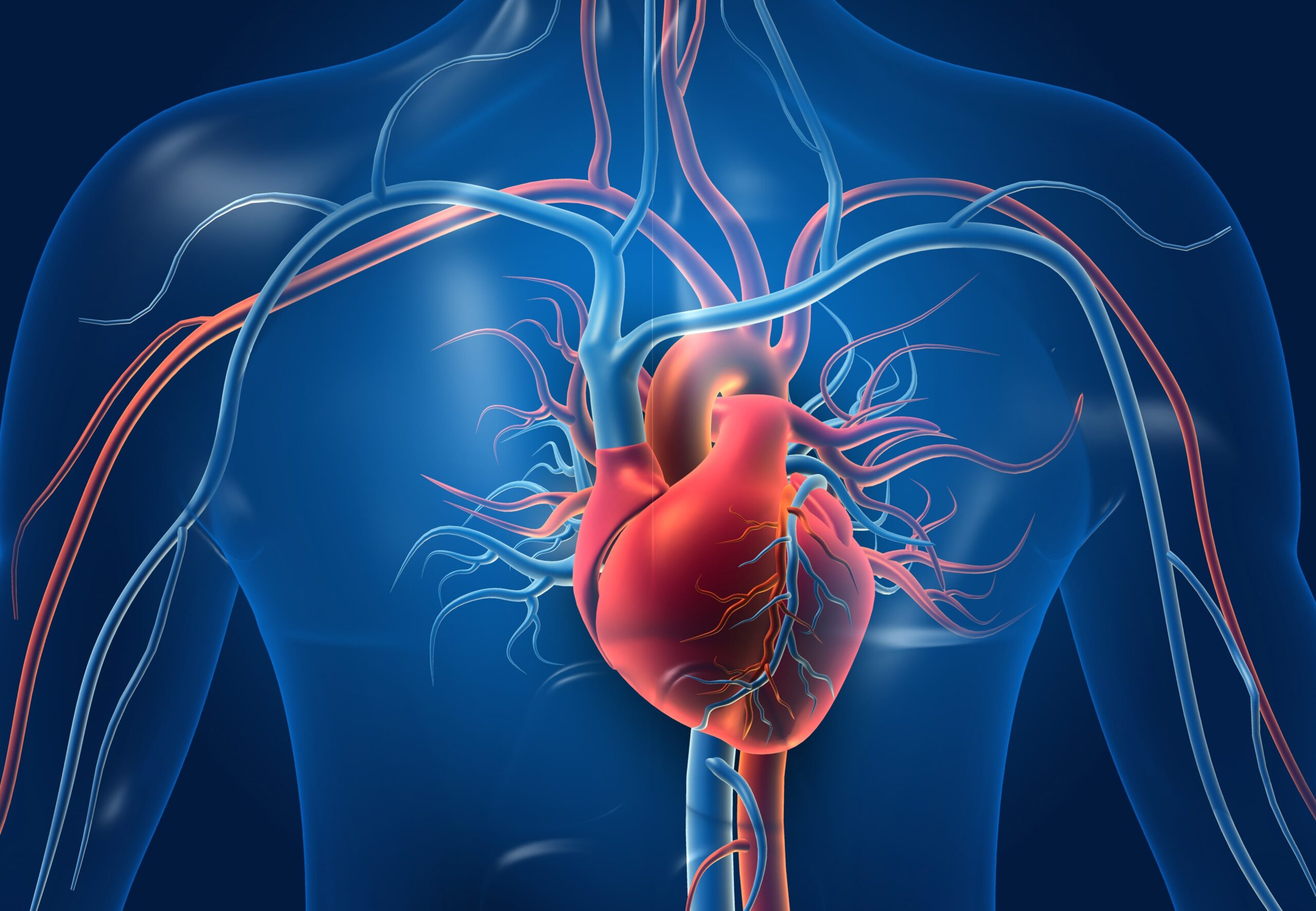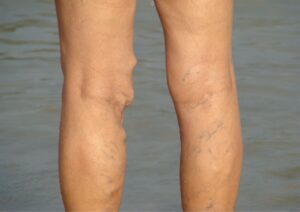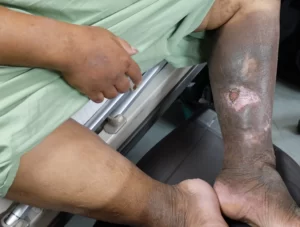Table of Contents
The circulatory system is responsible for transporting blood throughout the body. It includes the heart that pumps the blood and a closed loop system of blood vessels.
Oxygen-rich blood, which is full of oxygen from the lungs, is pumped out of the left ventricle and into the aorta, where it travels to the rest of the body.
Oxygen-poor blood, which is full of carbon dioxide, is pumped out of the right ventricle and into the pulmonary artery, where it goes to the lungs to be oxygenated.
However, cardiovascular disease can impair the proper functioning of this system. Blood also gathers food nutrients from the digestive system to distribute throughout the body, providing energy for bodily functions.
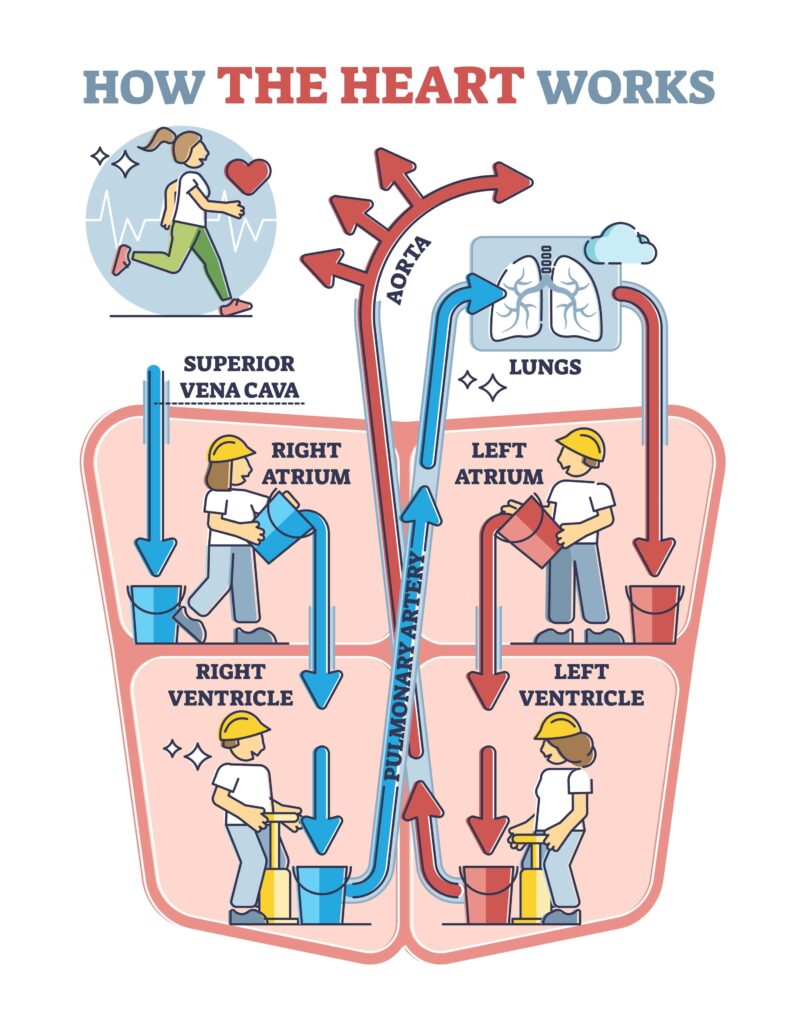
What is the function of the human heart?
The human heart is a muscular organ that is responsible for pumping blood throughout the body. It is located in the chest, between the lungs, and is roughly the size of a fist.
The main function of the human heart is to circulate blood throughout the body, providing oxygen and nutrients to the body’s tissues and removing waste products from carry blood, such as carbon dioxide. The heart achieves this by contracting and relaxing rhythmically, pumping blood through a network of blood vessels known as the circulatory system and pulmonary circulation.
The heart consists of four chambers divided into lower chamber and upper chamber: the right and the left side and atria, and the right and the left side ventricles. The atria receive blood from the body and lungs, while the left side and ventricles pump blood out to the body and lungs. The heart is also equipped with valves that ensure that blood flows in the correct direction through the heart and blood vessels.
In addition to its role in blood circulation itself, the heart also plays an important role in regulating blood pressure and maintaining homeostasis in the body.
What does the heart’s electrical system do?
The whole heart muscle’s electrical system is responsible for controlling the rhythm of the heartbeat. The electrical system of the heart muscle is made up of specialised cells that generate and transmit electrical impulses, which cause the heart muscles to contract and pump blood.
The electrical system of the heart begins in left atrium with the sinoatrial (SA) node, which generates electrical impulses that spread throughout the atria and push blood into the ventricles. This is followed by the atrioventricular (AV) node, which delays the electrical impulse to allow the atria to fully empty before the ventricles contract. Finally, the bundle of His and its branches cause the ventricles to contract and pump blood out of the heart and into the arteries. Treatment for arrhythmias can include medication, electrical cardioversion, or other interventions.
What does the circulatory system do?
The circulatory system, also known as the cardiovascular circulatory system or, is responsible for transporting blood throughout the body. Its main function is to supply oxygen and nutrients to the body’s tissues and organs and to remove waste products low oxygen blood, such as carbon dioxide.
The circulatory system consists of the heart, blood vessels, and blood. The heart pumps blood through a network of blood vessels that includes arteries, veins, and capillaries. Arteries carry oxygenated blood away from the heart to the body’s tissues and organs, while veins carry deoxygenated blood back to the heart. Capillaries are small, thin-walled vessels that allow for the exchange of oxygen and nutrients, and waste products between the heart healthy blood supply and the body’s tissues.
The circulatory system also plays a role in regulating body temperature and maintaining homeostasis. Vessels of systemic blood circulation can constrict or dilate in response to changes in temperature, allowing the body to regulate heat loss or conserve heat. Additionally, the blood circulatory system work helps to maintain the body’s pH balance and electrolyte levels circulating blood throughout, which are important for proper cellular function.
Disruptions in the heart and circulatory system, can lead to a range of health problems, including heart disease, stroke, high blood pressure, and peripheral artery disease. Maintaining a healthy lifestyle, including regular exercise, a balanced diet, and avoiding smoking and excessive alcohol consumption, can help to prevent these conditions and maintain the health of the heart and circulatory system’s function.
How does blood flow around the heart and the body?
Blood flows around the heart and body in a closed system of vessels, which make up the circulatory system. The heart pumps blood through the vessels, and the blood circulates around the entire body then, supplying oxygen and nutrients to the tissues and organs and removing wastes.
The blood flow around the heart is as follows:
1. Oxygen-poor blood enters the right atrium of the heart from the body through the the superior vena cava and inferior vena cava.
2. The right atrium contracts, forcing the blood through the tricuspid valve into the right ventricle.
3. The right ventricle contracts, forcing the blood from right ventricle through the pulmonary valve into the pulmonary artery, which carries the blood to the lungs.
4. In the lungs, the blood picks up oxygen and releases carbon dioxide.
5. Oxygenated blood returns to the heart through the pulmonary veins and enters the heart’s left atrium first.
6. The whole left ventricle atrium contracts, forcing the blood through the mitral valve into four chambers of the left ventricle.
7. The left ventricle contracts, with less blood flowing, and forcing the blood through the aortic valve into the aorta, the body’s largest artery.
8. The aorta branches into smaller arteries, which carry the oxygen-rich blood to the body’s tissues and organs.
9. As the blood flows through the capillaries in the tissues, oxygen and nutrients diffuse from the blood into the blood cells within, and wastes such as carbon dioxide and lactic acid diffuse from the red blood cells back into the blood.
10. The deoxygenated blood then flows into the leg veins, which gradually merge into larger vessels and return the empty deoxygenated blood to the lungs and heart to start the cycle again.
Overall, blood flow is regulated by the pumping action of the the the heart pumps blood, and blood vessels, the elasticity and contraction of the vessels, and the presence of valves in the veins. The whole circulatory system and vascular system that function is essential for maintaining the health and function of the body’s tissues and organs.
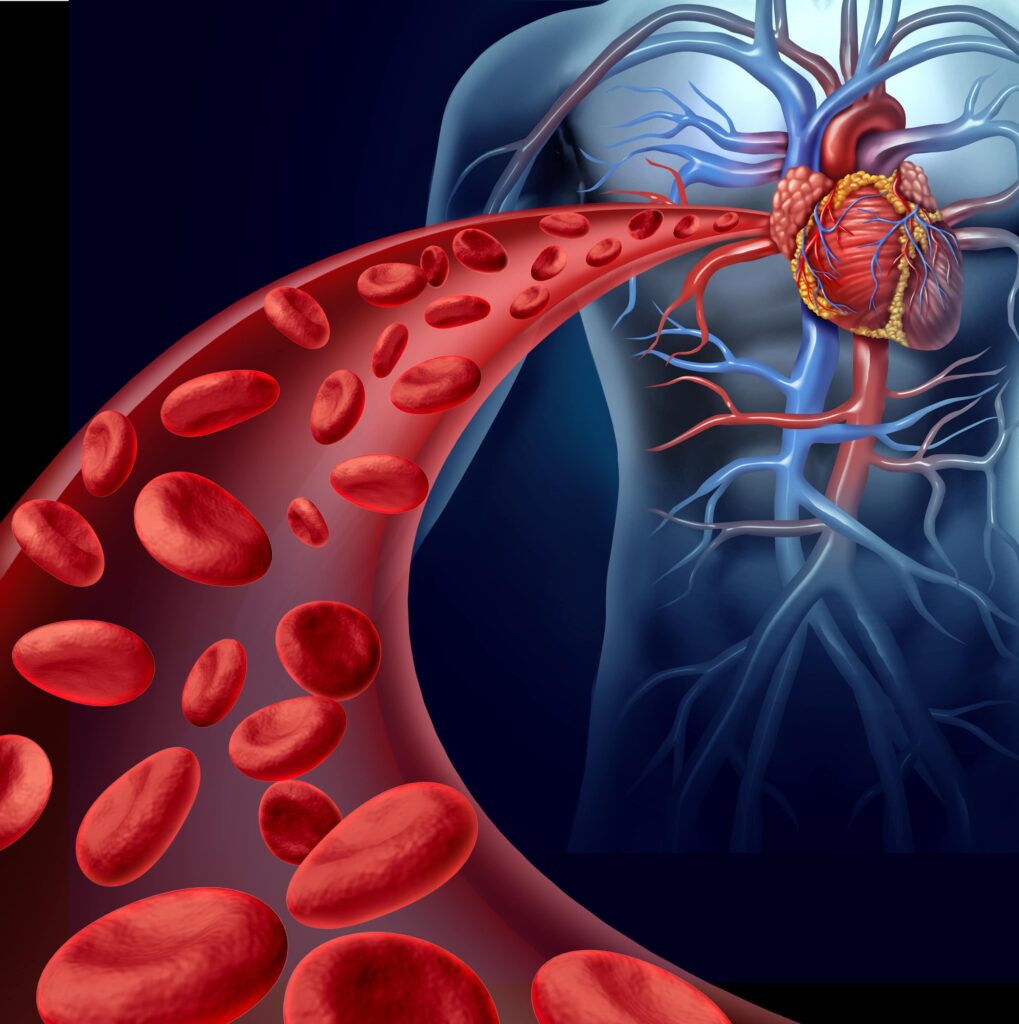
How do your heart and lungs add oxygen to your blood?
The heart and lungs work together to add oxygen to the red blood cells within. When your heart beats and you inhale, air enters your lungs and travels down into tiny air sacs called alveoli. These alveoli are surrounded by tiny blood vessels called capillaries. Oxygen from the air you breathe diffuses through the walls of the alveoli and into the capillaries, where it binds to the haemoglobin molecules in red blood cells. At the same time, carbon dioxide, a waste product of cellular respiration, diffuses from the capillaries into the alveoli and is expelled from the body when you exhale.
The oxygen-rich blood then travels from the lungs back to the heart where blood travels through the pulmonary veins and enters the upper chamber. From there, it passes from the upper to the lower chamber or left ventricle, which pumps it out to the rest of the body through the aorta. As the oxygen-rich blood travels and circulates throughout the body, it delivers oxygen to cells and tissues, which use it to produce energy through cellular respiration.
Overall, the heart and lungs work together to ensure that your blood is constantly replenished with oxygen, which is essential for the proper functioning of your body’s cells and organs.
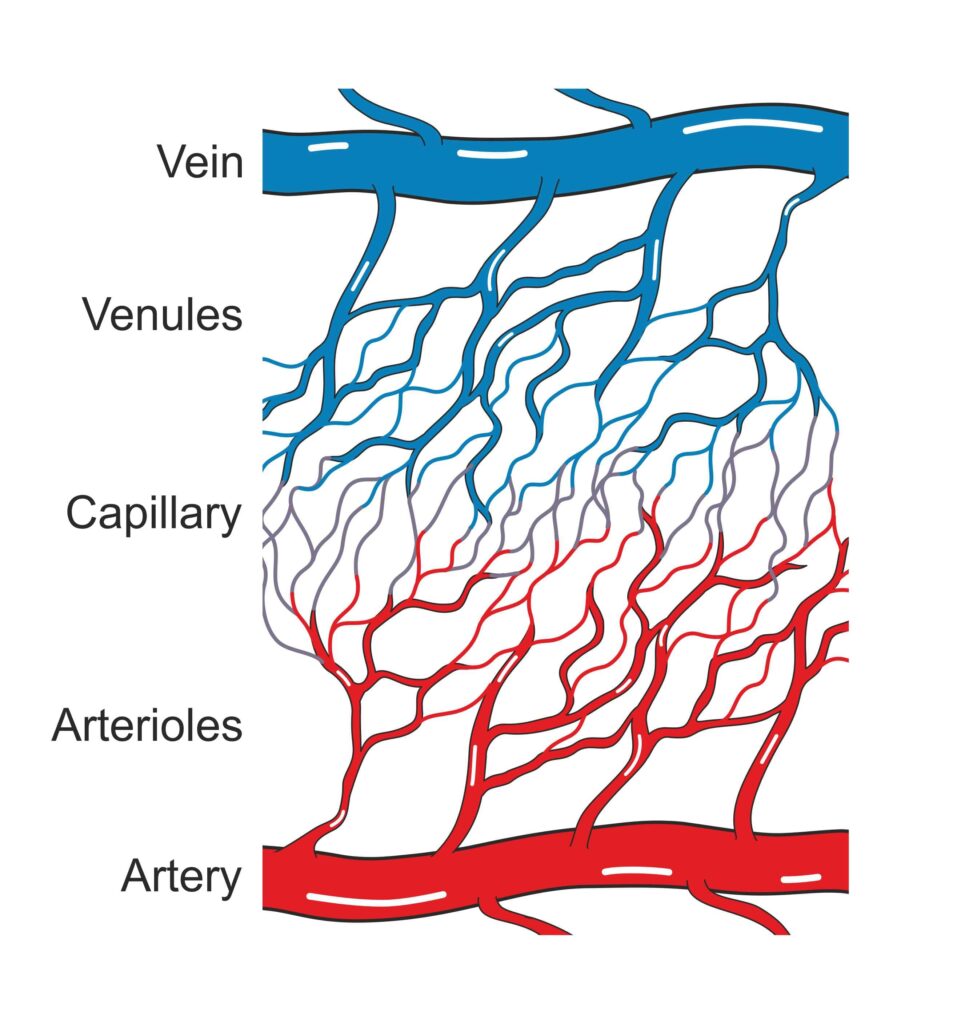
What are the types of blood vessels?
There are three types of blood vessels in the pulmonary artery and veins of the human body:
1. Arteries:
Arteries are thick-walled vessels that carry oxygenated blood away from the heart to the body’s tissues and organs. They have a smooth inner lining, a thick muscular layer, with thin walls and a tough outer layer. Arteries branch out into smaller arterioles and then into capillaries, which are the smallest blood vessels.
2. Veins:
Veins are tiny vessels that carry deoxygenated blood from the body, which pumps blood’s tissues pumps blood and organs back to the heart. They have thinner walls than coronary arteries, and have valves that prevent deoxygenated blood from flowing backward. Veins merge into larger vessels as they approach the heart and eventually become the vena cavae, which are the largest veins in the body. They constitute the venous system.
3. Capillaries:
Capillaries are the smallest vessels and are responsible for exchanging oxygenated blood, blood gathers food nutrients, and wastes between the blood and the body’s tissues. They have a thin, permeable wall that allows for the exchange of gases, oxygenated blood gathers food nutrients, and wastes. The capillary network connects arterioles to venules, which are small veins that eventually merge into larger veins.
What causes your heart and circulatory system to go wrong?
High blood pressure, high cholesterol, smoking, diabetes, family history of cardiovascular diseases, lack of exercise, poor diet, and obesity are all risk factors for heart and other circulatory system problems. High blood pressure can damage the walls of the blood vessels and lead to heart disease, stroke, and kidney disease. Smoking can damage the walls of the blood vessels, increase the risk of blood clots, and raise blood pressure. Diabetes can damage artery walls of the blood vessels and increase the risk of heart disease, stroke, and other complications.
What puts me at risk of heart and circulatory disease?
Age, family history, smoking, high blood pressure, high cholesterol, diabetes, lack of physical activity, unhealthy diet, obesity, and chronic stress are all factors that can increase the risk of heart and circulatory diseases. Smoking can damage blood vessels, high blood pressure can damage blood vessels, high cholesterol can lead to plaque buildup in coronary arteries, diabetes can damage blood vessels, lack of physical activity, unhealthy diet, obesity, and chronic stress can all increase the risk of cardiovascular disease.
What conditions affect the circulatory system?
The circulatory and cardiovascular system also is affected by many conditions, such as atherosclerosis, coronary artery disease, peripheral artery disease, hypertension, heart failure, arrhythmias, valvular heart disease, deep vein thrombosis, pulmonary embolism, and anemia. These conditions can lead to reduced blood flow and increased risk of heart attack and stroke.
What are Cardiovascular diseases?
Cardiovascular or cardiovascular disease, is a range of conditions that affect the heart and blood vessels, such as coronary artery disease, heart attack, stroke, high blood pressure, heart failure, arrhythmias, and valvular heart disease. It is a major cause of death worldwide, but many risk factors can be prevented or treated with lifestyle changes and medical interventions.
What system does the circulatory system work with?
The circulatory system works with several other systems in the body, including:
1. The respiratory circulatory system:
The respiratory how does the blood circulatory system work and helps to oxygenate the blood by exchanging gases in the lungs.
2. The digestive system:
The digestive system breaks down food into nutrients, which are then absorbed into the bloodstream and transported to the rest of the body.
3. The lymphatic system:
The lymphatic system is a network of vessels and organs that help to remove excess fluid and waste products from the body’s tissues. It also plays a role in fighting infection cardiovascular disease.
4. The endocrine system:
The endocrine system produces hormones that are transported through the bloodstream to target organs and tissues.
5. The nervous and cardiovascular system:
The nervous system controls the heart rate and blood pressure, and helps to regulate blood flow to different parts of the body.
Together, these systems work to maintain the body’s internal balance, or homeostasis, and keep it functioning properly.
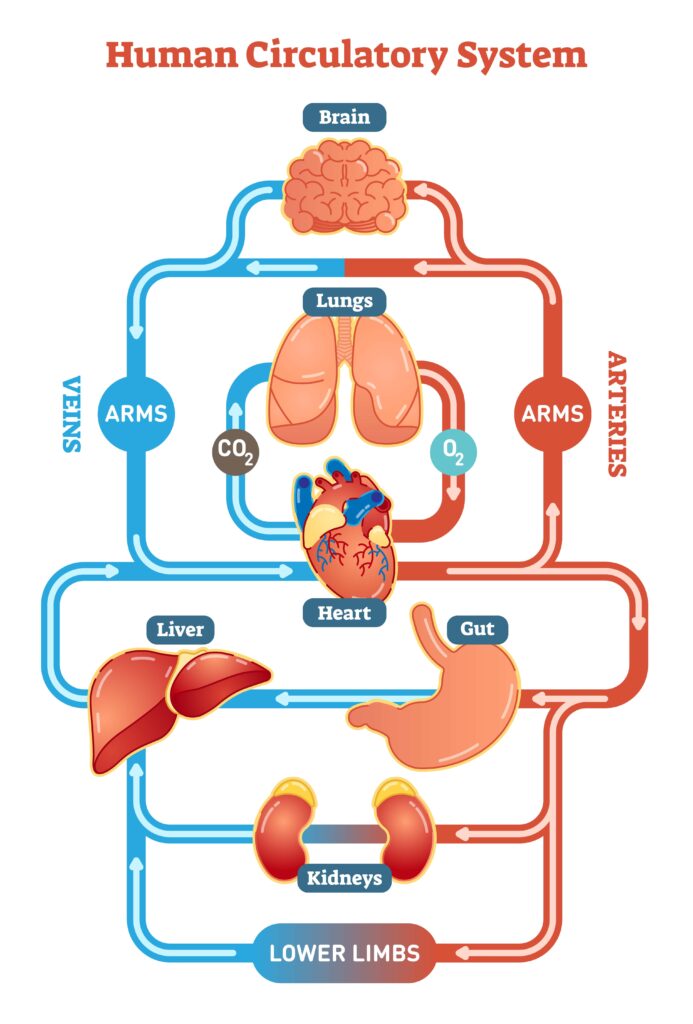
Conclusion
The circulatory system is a vital component of the human body, responsible for the transportation of blood throughout the body. It consists of the heart, blood vessels, and blood, working in conjunction with other systems to maintain homeostasis and provide oxygen, nutrients, and waste removal to the body’s tissues and organs. The heart, with its four chambers and electrical system, pumps blood and regulates the rhythm of the heartbeat. The blood vessels, including arteries, veins, and capillaries, form a closed loop system that facilitates blood flow. However, disruptions in the heart and circulatory system can lead to various health issues. It is crucial to maintain a healthy lifestyle to prevent cardiovascular diseases and ensure the proper functioning of this essential system.

